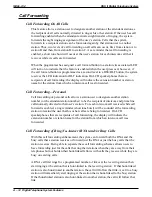
Forced Account Code Entry For CENTREX Users
The programmer may set the TAP time so that CENTREX users do not have to re-enter
an account code after pressing the TAP button. The programmer may also set the system
so that non-CENTREX users do have to enter an account code after pressing TAP.
•
If the TAP time is set for 1 second or less (the hookflash time), the system will not
clear an account code after a TAP entry. This enables CENTREX users to do host
system transfers without entering an account code a second time.
•
If the programmer sets the TAP time for 1.5 seconds or more (the recall time), the
system clears the account code after TAP entry. This forces non-CENTREX users
to re-enter an account code if they press TAP to recall a new dial tone.
Account Code Button
A programmer can use station class of service programming to assign an account code
button to any programmable button location at a station as part of the button mapping
procedure. With this account code button available, the user can press it and then dial an
account code without interrupting the call. Only the user of the Account Code button will
hear the DTMF tones when he or she dials the code. The distant on-line party will not
hear the DTMF tones, and the system will not place the line on hold. The user can hear
the distant on-line party while he or she is dialing an account code. If the telephone does
not provide an account code button, the user must dial an intercom code before he or she
dials the account code digits.
All-Call Paging
All-call paging allows all stations to receive announcements through the station speaker
at once. The system can also send all-call paging to the paging port where it applies it to
the input of an external paging amplifier. Origination of announcements must be via the
station handset. A programmer can arrange each station to receive and/or originate
all-call page. He or she enables the ability to receive and originate all-call paging at a
station through station class of service programming.
See also, Paging.
Analog Terminal Interface Support
The digital telephone system supports the operation of the Analog Terminal Interface
(ATI-D). The ATI-D is a multipurpose on-premise accessory with dual circuits that
provide an industry-standard telephone interface. This feature adapts most
industry-standard (IST) devices and voice processing systems to the digital telephone
system. The ATI-D accepts both tone and pulse (rotary) dialing from these devices. Each
ATI-D circuit will drive a load with a maximum ringer equivalence number (REN) of 2.0
thus allowing more than one IST connection at each ATI-D circuit input. The ATI-D
supports a wide variety of IST equipment such as model 500 and 2500 telephones,
cordless telephones, answering machines, and FAX machines. The ATI-D is housed in a
metal enclosure and is powered by the telephone system through the station port
IMI66–132
DSU II Digital Telephone System
A – 4 Digital Telephone System Features
Summary of Contents for DSU II
Page 31: ......
















































